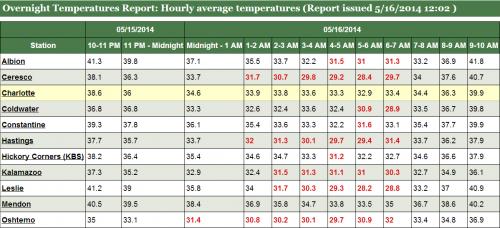Potential for frost damage in early emerged corn and soybeans
Early morning temperatures on Friday, May 16, 2014, dipped dangerously low for emerged corn and soybeans in South Central Michigan.

When the cold north winds blow and the skies clear in the early evening in May, most fruit growers in Southwest Michigan know all too well that trouble lies just over the horizon. Often, the winds die down at night and frosts and freezes follow. Low temperatures may have impacted early planted corn and soybean fields in many areas over southern Lower Michigan during the early morning hours of Friday, May 16, 2014.
The critical temperature for freeze injury to emerged corn and soybeans is 28 degrees Fahrenheit. While frost injury may occur at temperatures in the mid-30s, temperatures at or below 28 F for more than a few hours at a time can cause plant death in these crops. A quick look at Michigan State University Enviro-weather’s "Overnight Temperatures/Hours Below Freezing Report" shows low temperatures around 29 F in Coldwater and Ceresco, Michigan (Calhoun County), and Oshtemo, Michigan (Kalamazoo County), overnight. The period of time that these extreme temperatures were recorded was not very long, which is an encouraging sign. However, because these stations are not necessarily located in the lowest elevation locations across the region, there is plenty of potential for the temperatures in low-lying fields to have dipped below the 28 F threshold for freeze injury.

So what fields are at risk? Most of the fields that have been planted to corn were planted in the last week to 10 days. These fields have not yet emerged, or are at spike, and should not be at risk. The more advanced fields that I have seen are at V1 approaching V2. Most of these fields are likely to have suffered frost injury given the overnight temperatures. The real concern comes if the temperature slid below 28 F for significant periods. Since the growing point is around 0.75-1 inch below ground – the growing point for corn remains below the soil surface until the plants reach the V4-V5 leaf stage – most plants exposed to below freezing temperatures at this growth stage, even though they may show symptoms of frost damage, should not be killed.
Frost injury will first appear as water-soaked areas of leaf tissue that turns brown during the next several days. Purdue University corn agronomist Robert Nielsen suggests that growers wait three to five days to fully evaluate the effects of frost or freeze injury in affected corn plantings. Plants should begin to show signs of new growth by this period. If no new growth appears, you can evaluate the health of the growing point of the plants by digging up a few and examining the tissue just below ground. White tissue is healthy while water-soaked or browned tissue is damaged. Lower areas in fields are more likely to be impacted in fields with variable topography. Nielsen's archives from 2001 provide excellent pictures of frost damage and probable plant survival for both corn and soybean seedlings.
In soybeans, the growing point is located above ground at the top of the plant. Hard freeze injury can lead to plant death easier in soybeans than corn. However, sometimes the lateral terminal bud is damaged, but the lateral buds can continue growing, which leads to shorter but highly branched soybean plants, which still can produce significant yields.
Given the temperatures and duration of the frost, we are likely to see widespread tissue damage symptoms in emerged field crops. Michigan State University Extension advises growers to monitor their fields to see if the they are growing out of the injury early next week. The forecast is calling for a return to warmer conditions by the end of the weekend, which should encourage new growth.



 Print
Print Email
Email




